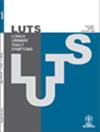A Comparison of Spinal Alignment and Trunk Mobility in Parkinson's Disease Patients With and Without Lower Urinary Tract Symptoms
Abstract
Introduction
Lower urinary tract symptoms (LUTS) in Parkinson's disease (PD) primarily result from neurological abnormalities. Yet, the impact of postural abnormalities and muscular rigidity on lower urinary tract symptoms remains unclear. This study aims to compare spinal alignment and trunk mobility in PD patients with and without LUTS.
Methods
A total of 93 patients were included in this cross-sectional study. Two groups were created based on the presence of LUTS. The study was completed with 57 symptomatic and 36 asymptomatic patients. The presence of LUTS was determined using the International Prostate Symptom Score. The Urinary Symptom Profile questionnaire was used for LUTS classification. Spinal posture and trunk mobility were measured using the Spinal Mouse.
Results
Compared to the asymptomatic controls, decreased lumbar lordosis (p = 0.022) and increased anterior trunk tilt (p = 0.026) were evident in symptomatic patients. However, no significant differences were found in thoracic kyphosis or lateral spinal curvatures (p > 0.05). Asymptomatic patients demonstrated greater lumbar mobility and total trunk mobility in both the sagittal plane (p = 0.002; p = 0.023) and the frontal plane (p = 0.024; p = 0.046), respectively.
Conclusions
PD patients with LUTS demonstrate distinct alterations in spinal alignment and trunk mobility compared to those without symptoms. These biomechanical differences may reflect compensatory mechanisms or additional motor involvement contributing to urinary dysfunction in this population.

 求助内容:
求助内容: 应助结果提醒方式:
应助结果提醒方式:


